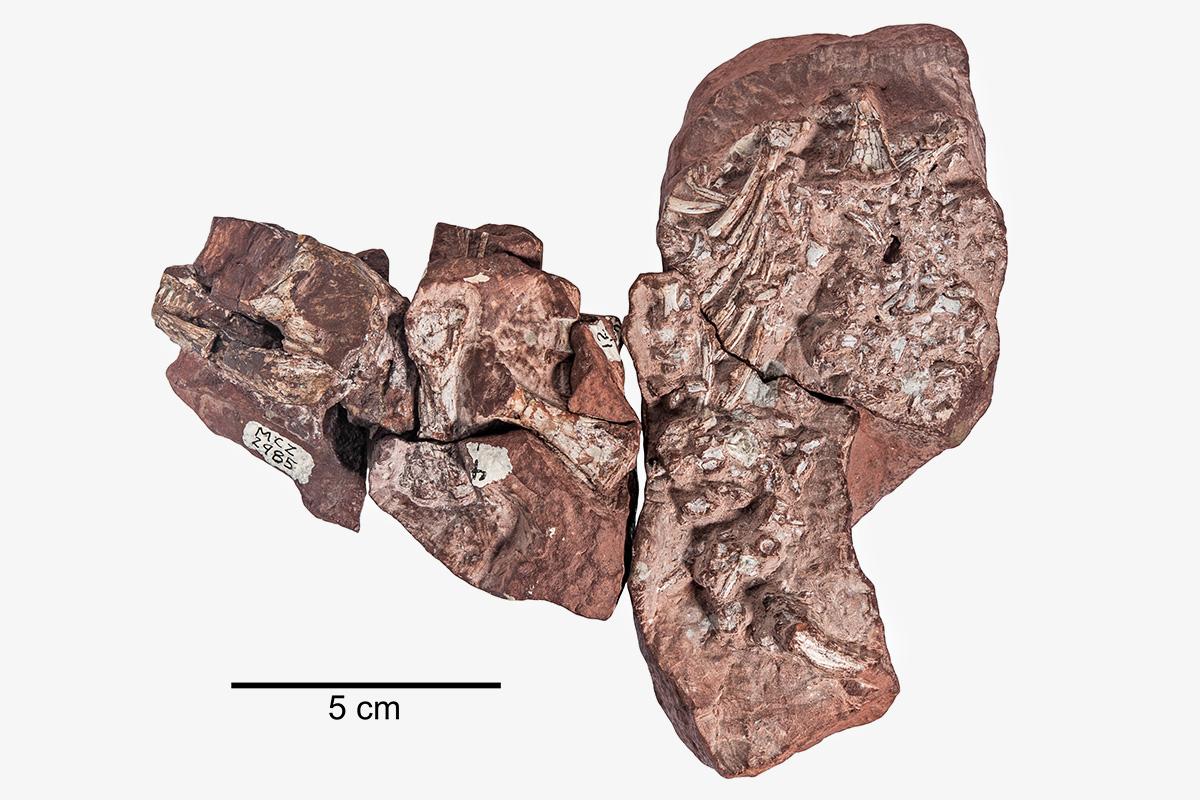A re-examination of a distant fossil relative of mammals from the Permian period by researchers at the Museum für Naturkunde Berlin, the University of Toronto Mississauga, and the European Synchrotron Radiation Facility in Grenoble, has revealed hidden features in the skull, including an extremely dense field of exceptionally large teeth on its palate.
The specimen was named Vaughnictis smithae in honour of the late Peter Vaughn, a noted American vertebrate palaeontologist, who first described it in 1965. The small fossil (estimated body length of 70 cm) was found in Colorado, USA, and is of early Permian age, almost 300 million years old. At that time, all continents were united in the supercontinent Pangaea with the southern USA being in an equatorial position. Geological evidence from the fossil site indicates that Vaughnictis was living in an arid environment with highly seasonal rainfall.
Partly because it was not a “pretty fossil”, the specimen received little attention since its original description, but the international team of scientists suspected that this fossil was much more important scientifically than originally thought and held some exciting secrets that modern paleontological techniques could reveal. Thus, they used the intense X-ray source from the European Synchrotron Radiation Facility to reveal details previously covered by rock. "The specific features of the X-ray beam generated by synchrotron radiation gives us the opportunity to have a lot more contrast in the final images compared to laboratory or medical computer tomography. This is especially important in our field of palaeontology as the surrounding rock and the fossilized bones have a very similar density" said Dr. Vincent Fernandez of the European Synchrotron Radiation Facility.
Using newly-revealed morphological details, the team was able for the first time to assign the specimen to a very important but enigmatic family called Eothyrididae. This is the rarest and one of the most basal groups of synapsids, the long evolutionary lineage leading to mammals. This discovery adds valuable new information about the initial, crucial chapter of vertebrate evolution, more than 300 million years ago, when the two main branches of land vertebrates separated, one leading to dinosaurs and birds and other reptiles, and the other leading to mammals, two spectacular evolutionary stories spanning three Eras of earth history.
Among the unusual features revealed by this method, described in a paper to be published in open access journal PLOS ONE, was the dentition on the roof of the mouth. While palatal dentition is the primitive condition for terrestrial vertebrates, there has been an overall evolutionary trend towards reduction and loss. In contrast, Vaughnictis possessed a particularly large number of teeth densely packed on the palate, some of them being extremely large, nearly the same size as the marginal teeth. “There isn’t really any modern animal with a similar set of teeth”, said lead author Dr. Neil Brocklehurst, of the Museum für Naturkunde Berlin. “The closest living relatives of Vaughnictis, the mammals, have lost the palatal dentition entirely and even the few modern reptiles with enlarged palatal teeth, like snakes and tuataras, are clearly not an analogue for this species.”
“It is difficult to imagine how these teeth were used, but it’s likely that they were ideal to hold onto struggling prey between the fleshy tongue and the field of teeth on the roof of the mouth”, said co-author Prof. Robert Reisz at the University of Toronto Mississauga.
“What is clear is that the eothyridids, previously considered a family of small, gracile animals, may have occupied a wider range of ecologies than thought. Vaughnictis, though small, is extremely robust and does not appear to be the agile insectivore that its close relatives are inferred to be”, said Prof. Jörg Fröbisch of the Museum für Naturkunde Berlin.
This research was sponsored by a Sofja Kovalevskaja Award of the Alexander von Humboldt Foundation, a research grant awarded by the DFG, and an NSERC Discovery Grant.
Publication:
Brocklehurst et al. (2016) A Re-Description of ‘Mycterosaurus’ smithae, an Early Permian Eothyridid, and Its Impact on the Phylogeny of Pelycosaurian-Grade Synapsids. PLOS ONE
Digital Media associated with this press release can be downloaded and used for free for news coverage related to this press release:
http://download.naturkundemuseum-berlin.de/presse/Vaughnictis
Credit:
Vaughnictis: Partial skeleton of the 300 million year of mammal relative Vaughnictis smithae. © Carola Radke – MfN.
Vaughnictis palatal teeth: A synchrotron tomography based reconstruction of the dense tooth field on the roof of the mouth of the 300 million year of mammal relative Vaughnictis smithae from the back of the skull (left) to the tip of the snout (right). © PLOS ONE.
Experiment: Example of a tomography setup at the ID19 beamline of the ESRF in Grenoble while scanning another mammal forerunner species. © Vincent Fernandez.
Contact:
Dr. Neil Brocklehurst, Tel: +49(0)30 2093 8306, E-mail: neil.brocklehurst@mfn-berlin.de
Prof. Dr. Jörg Fröbisch, Tel: +49(0)30 2093 8941, E-mail: joerg.froebisch@mfn-berlin.de
